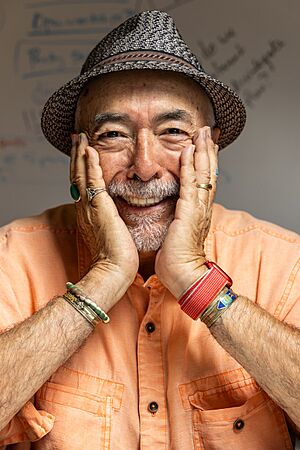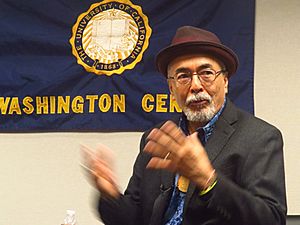Juan Felipe Herrera facts for kids
Quick facts for kids
Juan Felipe Herrera
|
|
|---|---|

Herrera pictured in 2024
|
|
| Born | December 27, 1948 Fowler, California, U.S. |
| Language | English; Spanish |
| Education | University of California, Los Angeles (BA) Stanford University (MA) University of Iowa (MFA) |
| Genre | Poetry |
| Literary movement | Chicano |
| Partner | Margarita Robles |
| United States Poet Laureate | |
| In office 2015–2017 |
|
| Preceded by | Charles Wright |
| Succeeded by | Tracy K. Smith |
Juan Felipe Herrera (born on December 27, 1948) is an American poet, writer, and teacher. He is also known as a performer, cartoonist, and activist. From 2015 to 2017, Herrera was the 21st United States Poet Laureate. This means he was chosen as a special poet for the country. He is a very important person in Chicano poetry, which is poetry written by people of Mexican-American heritage.
Herrera's childhood experiences greatly influenced his work. He grew up as the child of migrant farmers. His children's book, Calling the Doves, won an award in 1997. Community and art have always been important to Herrera. In the mid-1970s, he directed the Centro Cultural de la Raza. This was an old water tank in Balboa Park that became an art space for the community.
Herrera has written many books. These include fourteen collections of poetry, stories, and picture books for children. In total, he has published twenty-one books in the last ten years. His 2007 book, 187 Reasons Mexicanos Can't Cross the Border: Undocuments 1971-2007, explores ideas about identity. It includes texts in both Spanish and English. Herrera won the 2008 National Book Critics Circle Award for Poetry for his book Half the World in Light. In 2012, the governor of California, Jerry Brown, named him California Poet Laureate.
In 2011, Herrera became a chancellor of the Academy of American Poets. In 2015, he was chosen as the nation's first Chicano or Latino poet laureate. On June 11, 2016, Oregon State University gave Herrera an honorary doctorate degree. In August 2022, a new school opened in his honor. It is called Juan Felipe Herrera Elementary School.
Contents
Early Life and Education
Juan Felipe Herrera was born in 1948. His parents, María de la Luz Quintana and Felipe Emilio Herrera, were farm workers. Because of their work, Juan Felipe lived in many different places. He moved from crop to crop and lived in trailers and tents. These places were in the San Joaquín Valley and the Salinas Valley.
Herrera finished San Diego High School in 1967. He then received a scholarship to attend the University of California, Los Angeles. There, he earned his first degree in Social Anthropology. Later, he earned a master's degree from Stanford University. He also received a Master of Fine Arts in creative writing from the University of Iowa. In 1990, he was a special teaching fellow at the University of Iowa Writers’ Workshop.
After leading the Chicano and Latin American Studies Department at California State University, Fresno, Herrera moved. In 2005, he joined the creative writing department at University of California, Riverside. He also became the director of the Art and Barbara Culver Center for the Arts. This is a new space for different types of art in downtown Riverside. Herrera lives in Redlands, California, with his partner, Margarita Robles. She is also an artist and poet. He has five children.
Influences on His Work
Herrera's experiences as a campesino (farm worker) greatly influenced his writing. He traveled across California, from the San Joaquín Valley to San Diego's Logan Heights. He also spent time in San Francisco's Mission District. These three different parts of California inspire his work.
Growing up in the 1960s and going to college in the 1970s was a special time. It was during the Chicano Movement. This movement focused on the rights and culture of Mexican Americans. He was also inspired by experimental writers like the Beat Poets. Writers such as Luis Valdez and Allen Ginsberg influenced him. This time of artistic freedom inspired his writing style. He often mixes different styles, forms, and genres in his work.
Herrera often writes about important social issues. He is known for crossing boundaries in his writing. A writer named Ilan Stavans once said that Herrera is a constant presence in Chicano literature. He praised Herrera for creating a unique style. A critic from New York Times, Stephanie Burt, also praised Herrera. She said he was one of the first poets to create a new kind of art. This art mixes spoken word, written text, English, and other languages. It is rooted in ethnic identity and group pride, but also very individual.
Community Arts Projects
Herrera has received grants to teach poetry, art, and performance. He has worked in many different places. From 1983 to 1985, he taught at community art galleries like the Galería de la Raza in San Francisco. In 1977–1978, he helped create community art and literature posters in San Diego. He also taught poetry in prisons from 1987 to 1988. Currently, he works with community colleges and schools in Riverside County and the Coachella Valley.
After becoming California’s Poet Laureate in 2012, Herrera started a special project. It is called the i-Promise Joanna/Yo te Prometo Joanna Project. This project aims to stop bullying. Joanna was an elementary school girl who was bullied and died after a fight. The first part of the project asks students to send in poems about how bullying affects them. The second part encourages students to take action to prevent bullying. Herrera hopes to collect these poems and publish them as a book.
Awards and Fellowships
- Americas Award
- 2008 National Book Critics Circle Award in Poetry for Half the World in Light
- 2009 PEN/Beyond Margins Award
- 2010 Guggenheim Fellowship
- Breadloaf Fellowship in Poetry
- California Arts Council grants (awarded four times)
- Cooperative Children’s Book Center Choice
- Focal Award
- Ezra Jack Keats Award, for Calling the Doves
- Hungry Mind Award of Distinction
- Independent Publisher Book Award
- IRA Teacher’s Choice
- Latino Hall of Fame Poetry Awards (twice awarded)
- Los Angeles Times Book Award Nomination
- National Endowment for the Arts Writers’ Fellowship Awards (twice awarded)
- New York Public Library Outstanding Book for High School Students Award
- Pura Belpré Honors Award
- Smithsonian Children’s Book of the Year Award
- Stanford Chicano Fellows Fellowship
- Texas Blue Bonnet Nomination
- UC Berkeley Regent's Fellowship
- 2017 PEN Oakland Josephine Miles Award
- 2021 Los Angeles Review of Books/UC Riverside Creative Writing Lifetime Achievement Award
- 2023 Frost Medal
- 2024 MacArthur Fellow
Film, Stage, and Music Projects
Herrera created "The Twin Tower Songs." This was a performance in the San Joaquin Valley. It remembered the events of September 11, 2001. He also writes poetry for the PBS television series American Family. His musical, The Upside Down Boy, was very popular in New York City. It was produced by Making Books Sing. The story was written by Barbara Zinn Krieger. Juan Felipe Herrera wrote the lyrics, and Cristian Amigo wrote the music. Mr. Herrera is also on the board of two important organizations. These are the Before Columbus American Book Awards Foundation and the California Council for the Humanities.
On September 8, 2015, Herrera was officially named Poet Laureate. On that day, at the Library of Congress, he worked with the Chicago-Mexican son band Sones de Mexico. They wrote a song together in Spanish. It was called "Corrida de Sandra Bland" and honored a woman who had died. Sones de Mexico performed the song the next day.
In October 2016, LightBox Theatre Company put on a new play. It was called The Super Cilantro Girl. This play was based on three of Herrera's children's books. The play was written by Arnold Anthony Schmidt. It was directed by Stefani Tsai. The books it was based on are "The Upside Down Boy," "Calling the Doves," and "Super Cilantro Girl."
Theater Groups Founded
Juan Felipe Herrera has started several performance groups over the years:
- Teatro Tolteca (UCLA, 1971) – This group used jazz, spoken-word, and movement.
- TROKA (Bay Area, 1983) – This was a group that combined percussion and spoken word.
- Teatro Zapata (Fresno, Ca., 1990) – A student community theater group.
- Manikrudo: Raw Essence (Fresno, Ca., 1993) – A diverse performance art group and workshop.
- Teatro Ambulante de Salud/The Traveling Health Theatre (2003, Fresno, Ca.) – This group performed for migrant communities.
- Verbal Coliseum – A Spoken Word Ensemble (UC Riverside, 2006).
- His experimental play, "Prison Journal," was shown at the University of Iowa Playwright’s Festival in 1990.


